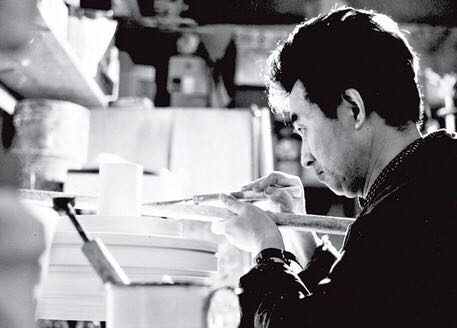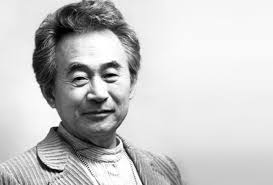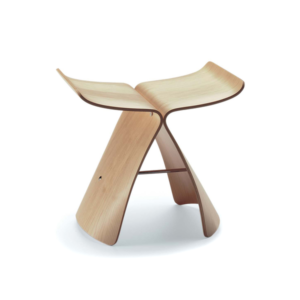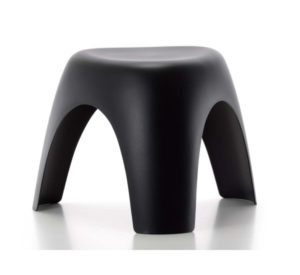Sori Yanagi Kitchen tool set
This Sori Yanagi kitchen tool set includes butter beater, turner, skimmer, four cradle, ladles.
Buy Now
We Love Japanese Food Easy Recipes & Best Restaurants


Sori Yanagi is a Japanese industrial designer. He was born in 1915 in Harajyuku, Tokyo, Japan between Soetsu Yanagi and Kaneko Yanagi. His father Soetsu is a founder of Mingei Movement which cerebrates beauty in every ordinary objects made by anonymous craftsman. Because of his father, Sori had many opportunities seeing and touching hand-crafted objects in his childhood, and it affected his sensitivity in design.
In 1934, Sori entered Tokyo Art School and studied western paintings. When he knew Le Corbusier by a lecture in the university, his interests started to move from paintings to designing objects and architecture. Le Corbusier and Charlotte Perriand influenced him when he worked in Japan in the early 1940s. In 1952, he established YANAGI DESIGN OFFICE, and is still remaining today.
After World War Ⅱ, he began industrial design. He played a huge role in developing Japan’s industrial design, and produced various products, such as furniture, Olympics torch holder, tunnel, kiosk and so on. One of the most famous works of him is the “Butterfly Stool”. It is selected as a permanent collection at The Metropolitan Museum of Art, Louvre Museum, and Stedelijk Museum Amsterdam.
His products represent his thinking “True beauty is not made, it is born naturally.”
That is why his designs are keep attracting people after no matter how much times goes by. Also, when he creates industrial products, he makes several models by hand with plaster, and uses them by himself to see whether they are easy to use or not. After making several corrections based on the actual uses, he makes a final model for a production. Stainless bowl was designed 60years ago, and is still loved by lots of people in Japan and many other countries. His simple but beautiful design and usefulness of his products come from his uncompromising work, and those are the reasons why he still has so many fans after he died.

Beauty of daily use – the concept of “Mingei(Folk craft)”- and the modern design generated by machinery and science age, those two contradictory factors created Sori Yanagi’s design. So what is Mingei and how are those affected on his design? Let’s explore his roots.
Soetsu Yanagi, Sori’s father, is a founder of Mingei movement. “Mingei”(民藝) is a word created by Soetsu Yanagi and his fellows, and it is translated as Folk Craft in English. Mingei-hin (folk craft items) means the items general people need in their daily life, and it can also be said that ”The craft of the people, by the people, for the people”.
Soetsu has his perspective that free and healthy beauties are represented in Mingei the most. And he tried to tell people that those beauties are the mainstream of the beauty, and saving and developing those culture made by people’s daily life can raise the quality of our life.
So what’s the concrete concepts of “Mingei-hin” preached by Soetsu? Here’s nine features explained by him.
Because of his father, he had many opportunities seeing and touching lots of “Mingei-hin” since he was a kid, and that helped him gain his artistic views. You can see those features in Sori’s designs. He is keep telling people the greatness of “Mingei” through his works, and now many people appreciate the beauty in his works.

Since Sori was surrounded by “Mingei” which is old-fashioned all the time, he started to have interests in a very different thing, Fin art. Then he entered Tokyo Art School to study western art. One day he went to see a lecture of Takehiko Mizutani, who is just came back from the study at Bauhaus, and he was pretty impressed by the lecture.
Two things that are most him in his mind are “Today is an age of machine and science”, and “Future design or art should be made for society or usage, and design live in a relationship with the society.” His lecture was somehow related to the concept of “Mingei”, but there was a defining difference between them, and it is that he has a positive view on machine and science. At that time these opinions were very new and he was very impressed by them. A short time later, he started to know Le Corbusier. He was extremely impressed with his book “La Ville Ladieuse(1930) ”. Many things written on the book were very inspirational for him and he started to think Le Corbusier is the way I live.
After he graduated from the university, he became an assistant of Charlotte Perriand who is a pupil of Le Corbusier. She came to Japan to instruct contemporary crafts. As they traveling the Japan, Perriand started to have strong interests in local houses or crafts, Sori began to have another look at his father’s thought.
If you use them with hands, why don’t you make them with hands?
This is Sori Yanagi’s opinion. When he create kettles, bowls, or even stools he make a plaster model by his own hands. When it’s small like kitchen tools he makes a real scale model. One time he uses a pottery wheel, one time carves out from wood. Then he uses the model by himself. Grab, shake, pile up… Use them like a completed product, and make corrections. Repeat this process many times. His atelier is like a laboratory. Spend 1-2 years for making one product is not a rare case. Takes time but this is the reason why his design is not only beautiful but so easy to use.
This Sori Yanagi kitchen tool set includes butter beater, turner, skimmer, four cradle, ladles.
Buy Now
Size: 24.7 x 17.8 x 4.2cm / Body weight: 960g / IH heater available.
Buy Now
This Sori Yanagi’s Kettle was the winner of the Good Design Award in Japan.
Buy Now
Thesse beautiful tongs are made of one sheet of flexible stainless steel.
Buy Now
Simple, durable and beautiful pot designed by Sori Yanagi.
Buy Now